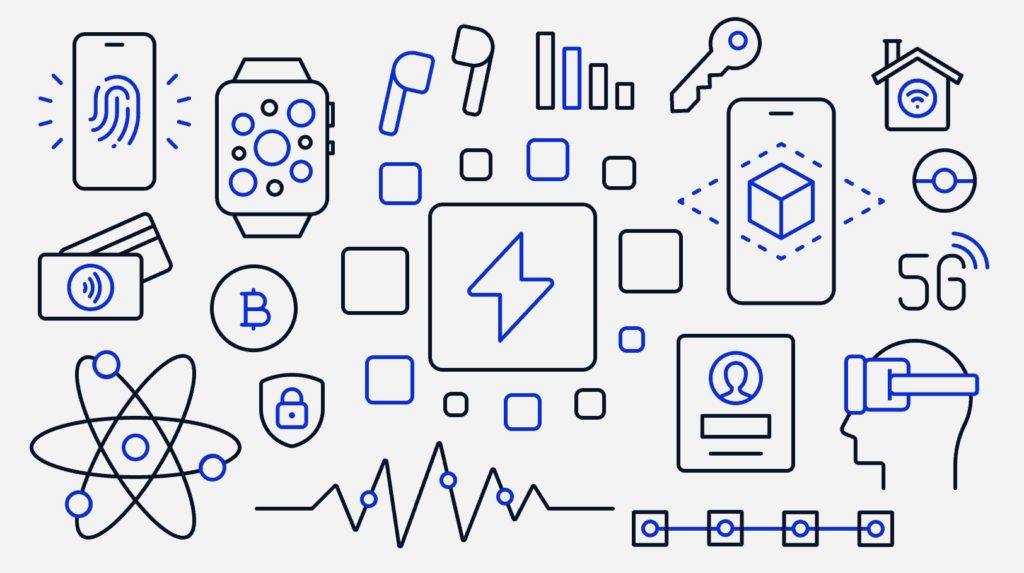Mobile app development has evolved significantly since the inception of the first mobile phone in the 1970s.
There is no indication that the pace of mobile app innovation is diminishing. Technologies such as AI, VR, AR, and blockchain are profoundly shaping the trajectory of mobile app development. Moreover, apps designed for smartphones and wearable devices continue to dominate the spotlight.
Let’s Kyanon Digital walk you through 5 mobile app development trends for the future in this blog.
1. The development journey of mobile apps
To understand the future of mobile app development, it’s crucial to look back at its history.
The journey began in 1973 with the invention of the first handheld cellular mobile phone. However, it wasn’t until 20 years later that commercially available cell phones started paving the way for today’s technology.
In 1993, IBM introduced Simon, the first phone with a touch screen and built-in apps, including a contact book and calendar.
In 2002, the Java-based Blackberry 5810 was released, featuring integrated apps like connected wireless email. This groundbreaking device set the stage for rapid app development, with Java remaining the primary development language for Android-based apps to this day.

A major milestone occurred in 2008 when both Apple and Google launched their online app stores. Apple’s App Store reached one billion downloads just nine months after its launch. By 2021, there were 230 billion first-time mobile app downloads worldwide across Apple and Android devices.
As mobile phones became ubiquitous and development surged, apps evolved in sophistication. Early apps primarily displayed information based on user inputs, but many of today’s apps can proactively provide users with information before being prompted.
2. 5 mobile app development trends for the future
2.1. 5G sets the foundation
The excitement surrounding fifth-generation ireless technology (5G) has been growing for nearly a decade, but most carriers only began rolling out 5G access in 2021.
5G’s primary advantage is its speed. It’s not just an improvement over 4G; it’s exponentially faster, capable of operating at 100 times the speed of most current networks. This significant boost in speed enables users to seamlessly connect with wearables, devices, and machines in addition to phones. With its high-speed capabilities, 5G transfers information in milliseconds, reducing latency and providing a superior user experience.
Use cases for 5G range from simple to complex. A straightforward example is users streaming HD videos on their devices without buffering or quality loss.
A more complex use case is described in a study by PwC, which envisions a 5G-enabled healthcare ecosystem. This ecosystem, comprising apps, IoT devices, and wearables, can help patients monitor their health and quality of life more effectively. It could also facilitate earlier disease detection and reduce healthcare costs by approximately $2,000 per patient.

2.2. AR & VR reach beyond gaming
Augmented reality (AR) overlays artificial images and objects onto real-life environments, as seen in games like Pokémon Go. Conversely, virtual reality (VR) creates entirely artificial environments, such as those experienced through Meta’s Oculus Quest 2, which lets users work out, explore new countries, and attend virtual concerts from their living rooms.
AR and VR are now expanding beyond the gaming world into various industries, including travel, real estate, and retail.
In real estate, AR technology has seen a significant surge, partly due to the COVID-19 pandemic. As in-person open houses became unsafe, rapid app development enabled virtual home walk-throughs.
Matterport, a 3D virtual tour platform, exemplifies this shift. In late 2020, Matterport released an iOS app that lets home sellers scan their properties using the LiDAR sensors on their phones or tablets—previously a capability reserved for expensive camera equipment.

Matterport – a 3D virtual tour platform (source: matterport.com)
According to Redfin, 63% of buyers who viewed virtual walk-throughs in late 2020 made offers on homes they hadn’t physically visited. Additionally, monthly views of 3D walk-throughs via the app increased by over 500% from February 2020.
2.3. AI is king
Artificial intelligence (AI) is not a new concept in mobile app development, but as AI and machine learning continue to advance, app capabilities are also evolving.
For instance, advanced machine learning algorithms can analyze past user behavior and use that data to predict future actions.
AI excels in areas like facial and speech recognition, which enhance safety features through biometric markers. This is particularly valuable for companies in sectors like insurance and finance, where AI and machine learning can bolster user safety, data security, and fraud detection. McKinsey estimates that AI could generate over $1 trillion annually for global banking.
As mobile and wearable payment methods become more prevalent, fraud detection will become increasingly critical. In 2020, there were 2.8 billion mobile wallets in use worldwide, with projections suggesting this number could reach 4.8 billion by 2025. As these wallets facilitate more online transactions, fraud detection companies are developing AI-driven technologies to help banks and retailers:
- Reduce false positives
- Enhance fraud detection
- Minimize investigation time

2.4. Wearables provide additional benefits
Wearables encompass a variety of devices, including watches, earbuds, and even smart clothing. They offer diverse functionalities, from voice-activated phone calls to tracking daily steps.
Currently, there are about 1 billion connected wearable devices worldwide. In 2021, the wearable technology market was valued at approximately $116 billion, with considerable growth anticipated.
While consumer electronics dominate the wearables market, there’s growing interest in their applications beyond basic step counting, particularly in healthcare. For instance, wearables like Fitbit and Apple Watch have received U.S. Food and Drug Administration clearance for electrocardiogram apps to monitor heart irregularities.
Looking ahead, wearables are expected to feature advanced smart app capabilities related to security. For example, Apple recently partnered with lock manufacturer Schlage to develop smart locks that can be opened with an Apple Watch or iPhone, and users can also store a virtual house key in their mobile smart wallet.

2.5. Security is a critical issue
As more personal information moves online, concerns about consumer security and privacy are intensifying. While consumer data is frequently collected to enhance services, particularly with AI and machine learning, fears about data breaches are legitimate.
A study by Synopsis revealed that 63% of popular Android apps contained open-source components with known security vulnerabilities, potentially exposing consumer information to hacking or leaks. This can negatively impact user experience and trust in an app.
To address these security challenges, two key innovations are emerging:
- Biometric Authentication: This method uses eye, facial, fingerprint, or voice recognition to verify users, offering a strong defense against fraud and data theft while being user-friendly.
- Distributed Ledger Technology (DLT): Blockchain is a prominent example of DLT, which enhances IoT security on mobile and other smart devices by adding multiple layers of encryption.

Transform your ideas into reality with our services. Get started today!
Our team will contact you within 24 hours.
3. What is the future of mobile app development?
The continued advancement of existing technologies and the creation of new ones will drive growth in the mobile app industry.
The incentives for developers are clear. Projections suggest that mobile app development will generate over $600 billion in revenue by 2025, with this figure representing just the beginning of the industry’s potential rewards.
Kyanon Digital stands out as a premier mobile app development vendor in the APAC region. Renowned for its expertise and innovation, Kyanon Digital is at the forefront of delivering user-centric design and development that cater to a diverse range of business needs.
Contact Kyanon Digital for consultancy from experts in the industry.
Get the Vietnam Software Outsourcing Pricing Guide 2025
Your shortcut to Vietnam’s outsourcing costs and key market insights.

Why work with Kyanon Digital?
- Expertise Trusted by Fortune 500 Clients
With deep experience serving Fortune 500 companies, we deliver tailored, high-impact solutions that meet the unique demands of global enterprises. - A World-Class IT Team
Our 500+ IT experts—spanning consulting, project management, technical architecture, software engineering, QA, DevOps, and AI/ML—are committed to excellence in every project. - Quality at the Core
Certified under ISO 9001, our quality-first approach guarantees precision, reliability, and continuous improvement. - Uncompromising Security
ISO 27001-certified, we integrate robust security into every process, leveraging advanced technologies to protect your data against evolving threats.



















